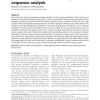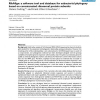474 search results - page 33 / 95 » A New Similarity Measure among Protein Sequences |
BIB
2006
13 years 9 months ago
2006
One of the major goals of computational sequence analysis is to find sequence similarities, which could serve as evidence of structural and functional conservation, as well as of ...
BMCBI
2006
13 years 9 months ago
2006
Background: Existing biological databases support a variety of queries such as keyword or definition search. However, they do not provide any measure of relevance for the instance...
BMCBI
2006
13 years 9 months ago
2006
Background: Until today, analysis of 16S ribosomal RNA (rRNA) sequences has been the de-facto gold standard for the assessment of phylogenetic relationships among prokaryotes. How...
BMCBI
2007
13 years 9 months ago
2007
Background: Phylogenetic profiles record the occurrence of homologs of genes across fully sequenced organisms. Proteins with similar profiles are typically components of protein c...
ICDE
2003
IEEE
14 years 10 months ago
2003
IEEE
Analyzing sequence data has become increasingly important recently in the area of biological sequences, text documents, web access logs, etc. In this paper, we investigate the pro...


